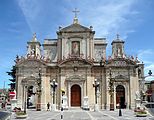Rabat (Malta)
| coat of arms | map |
|---|---|

|
|
| Basic data | |
| State : | Malta |
| Gzejjer : | Malta Majjistral (Northwest Malta) |
| Distretti : | Western film |
| Area : | 26,599.21 km² |
| Residents : | 11,470 (December 31, 2018) |
| Population density : | 431 inhabitants / km² |
| ISO 3166-2 : | MT-46 |
| Postal code : | RBT |
| Website : | www.rabatlocalcouncil.com |
| politics | |
| Mayor : | Sandro Craus ( MLP ) |
Coordinates: 35 ° 53 ' N , 14 ° 24' E
Rabat (or Ir-Rabat ) is a town right next to the old city of Mdina in central Malta .
The village of Baħrija also belongs to Rabat .
The history of the place goes back about 2,000 years when it formed part of the ancient Roman city of Melita. During the time of the Arab rule over the island, the city was renamed Mdina, while the part outside the city walls was called Rabat, which means suburb.
Attractions
- The church of St. Paul was built in memory and in honor of the apostle Paul and his converted bishop Publius . Legend has it that the apostle lived in the grotto named after him below the right aisle during his three-month stay on the island of Malta, until he succeeded in converting the Roman governor Publius to Christianity. In the grotto there is now a statue of the apostle, in another grotto, which apparently served as a prison, there are holes in the ceiling to which the prisoners were tied. There are also frescoes from the 16th century.
- The St. Agatha catacombs were used from 3rd to 5th centuries. Century as burial places. Different types of graves can be seen, and some frescoes from the time they were built still exist. It is here that Saint Agatha is said to have hid for a time from the stalking of the pagan governor of Sicily, Quintianus. The underground chapel at the entrance contains frescoes from the 12th – 13th centuries. Century
- The St. Paul catacombs are the largest in Rabat, the labyrinthine corridors lead to numerous graves.
Others
Parts of the films Munich and Troy were shot in Rabat.
sons and daughters of the town
- Joseph Calleia (1897–1975), actor
- Paul Xuereb (1923–1994), politician and President of the Republic of Malta (1987–89)
- Daniel Micallef (* 1928), diplomat and politician
- Sylvester Carmel Magro (1941–2018), religious
- Marlene Mizzi (* 1954), politician
- Carmel Busuttil (born 1964), football player
- Michaela Paris (* 1969), singer
- Debbie Scerri (born 1969), singer
- Adrian Mifsud (* 1974), football player
Web links
Commons : Rabat - collection of pictures, videos and audio files
Wikivoyage: Rabat (Malta) - travel guide
Individual evidence
- ↑ StatDB of the National Statistics Office Malta , accessed on August 1, 2020



